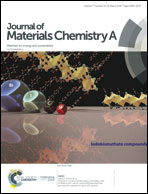Low-volume-change, dendrite-free lithium metal anodes enabled by lithophilic 3D matrix with LiF-enriched surface†
Abstract
Lithium metal anodes having significantly high specific capacity and low potential are considered as the most promising candidates for high-energy-density batteries. However, severe dendrite growth and infinite volume change seriously limit their practical applications. Achieving stable lithium anodes with high areal capacity at high current density is still a challenge owing to the worse conditions. Here, we reported an ultrahigh-performance lithium metal anode enabled by a 3D CuO@Cu matrix with LiF-enriched surface (LiF@Li matrix) via the synergistic effect of the three-dimensional skeleton and the stable artificial solid-electrolyte interface. In this strategy, a LiF@Li matrix was fabricated through the infusion of molten Li into a 3D CuO@Cu matrix followed by NH4F coating. In this way, a lithium anode having high areal capacity (5 mA h cm−2) with excellent stability for 350 h at a current density of 5 mA cm−2 was demonstrated in a carbonate electrolyte without any additive. The corresponding LCO|LiF@Li full cell demonstrated high-rate performance with enhanced long-term stability (82.4% retention after 1000 cycles at 2C). The strategy may open up a new way to fabricate highly stable and dendrite-free Li metal anodes.

- This article is part of the themed collection: 2019 Journal of Materials Chemistry A HOT Papers


 Please wait while we load your content...
Please wait while we load your content...